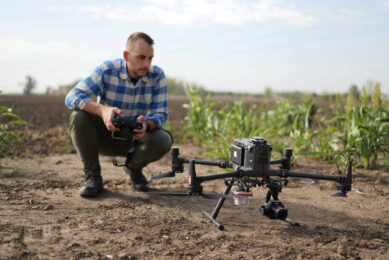Robot swarm boosts big yield in Brazil

A robotic fleet raised soybean yields by 10 bags/hectare, an 18% increase, on a large farm in Goiás. The pioneering system also cut herbicide use by up to 85% over 1,500 hectares.
The challenge of controlling weeds in vast grain fields solely with robots appears to have been successfully overcome, albeit not without a few bumps.
In Brazil, the futuristic scene of a swarm of robots is now a reality. Aimed at reducing costs, labour dependency, and boosting sustainability, they are already delivering up to 18% gains in productivity.
At Fazendas Reunidas, a large-scale operation in Rio Verde (GO), the use of Solix robots developed by Solinftec led to a 10-bag/ha yield increase in soybean fields compared to conventional weed management.
The pioneer behind this innovation is Alexandre Baumgart, a chemical engineer and CEO of Fazendas Reunidas. He expanded his investment from 2 robots to a fleet of 12 in just 1 year, committing more than US$ 600,000 to scale up the project. “The concept is solid. I push technology to its limits, and I can say this one truly delivers clear results,” Baumgart says.

Real life
It all started during the 2023/24 harvest with a pilot project. 1 robot handled imaging and weed mapping, while another performed spot spraying of invasive plants. Even the first results were promising. Herbicide use dropped by 85%, while productivity rose. “Soybeans can tolerate herbicides, but they are not immune. Processing those chemicals consumes energy from the plant,” explains Baumgart.
The Solix robots proved more precise than traditional sprayers, allowing the soybean plants to conserve energy. Encouraged by the data, Baumgart expanded the programme in 2024/25, acquiring 10 more units and assigning them to cover 1,500 hectares. Despite repeating the productivity gains, the scaled-up operation faced its hurdles.

Fungal setback
An outbreak of fungi required urgent intervention across two-thirds of the robot-managed area (about 1,000 ha), forcing the farm to use conventional sprayers for speed. The robotic swarm thus operated autonomously on 500 hectares, still delivering the same 10-bag-per-hectare gain. “The tech works. But operating robots at scale demands discipline, method and operational tweaks. The concept is right, but the implementation still involves a learning curve,” says the CEO.

Challenges of scale
Two improvement fronts are already under study: robot speed and chemical refilling. Currently, Solix must return to base for refilling, which slows operations. Solutions include exploring new engine types and developing autonomous in-field refill units. Each Solix robot covers roughly 150 hectares — the upper limit for the current electric motors moved by photovoltaic energy.
“They still struggle with fast infestations that require rapid response. We’re learning how to better allocate units and act faster. Another route might be combustion engines,” says Baumgart.
According to him, the plan is to expand to 20 robots. “I still want to double-check, but it’s a real possibility. It depends on the evolution of the equipment”

Development
Solinftec, during Agrishow 2025, launched its new Refill Station platform to address chemical logistics. “Problems happen here, and they solve them. I didn’t buy a finished product. In a way, I’m helping develop it,” says Baumgart, who proudly admits to “stress-testing” technologies.
In his view, within 3 years the technology will be mature for large-scale deployment. “Agriculture will change. Maybe not everything will be 100% autonomous, but these platforms will become standard. We’ll need more analytical and technically skilled operators.”
Solix’s potential goes beyond herbicides — future applications could include biologicals and insecticides, possibly assisted by drones. “Every time you analyse one aspect, you discover a whole new avenue,” he says.

Solinftec’s perspective
According to Emerson Crepaldi, Solinftec’s COO for South America, Baumgart is now one of the company’s flagship cases. “Fazendas Reunidas was the first to scale robotic operations. Their productivity results and herbicide cuts are now industry benchmarks. We’re even seeing soil quality improvements due to lower chemical loads.” Solinftec currently has around 150 Solix units operating in Brazil, Latin America, and the United States.
At Agrishow 2025, the company unveiled the 4th-generation Solix model — more robust, terrain-flexible, and suitable for varied irrigation systems and producer profiles. “Robots are no longer a question of ‘if’, but ‘when’. Farmers see this as the future of farming,” says Crepaldi.


Alice: the brain
According to Robson Dias, Solinftec’s grain commercial manager, the secret lies in “Alice” — the company’s AI platform. “Alice is the brain. She connects, analyses, and coordinates real-time data from over 60,000 devices — from sensors and weather stations to the Solix units themselves,” he explains. This integrated data stream allows Alice to generate highly accurate insights.
One of Alice’s biggest strengths, Crepaldi points out, is that she’s brand-agnostic. “Unlike closed ecosystems, ours is open. That gives us access to a much more robust and diverse Big Data set,” he finishes.
Join 17,000+ subscribers
Subscribe to our newsletter to stay updated about all the need-to-know content in the agricultural sector, two times a week.



